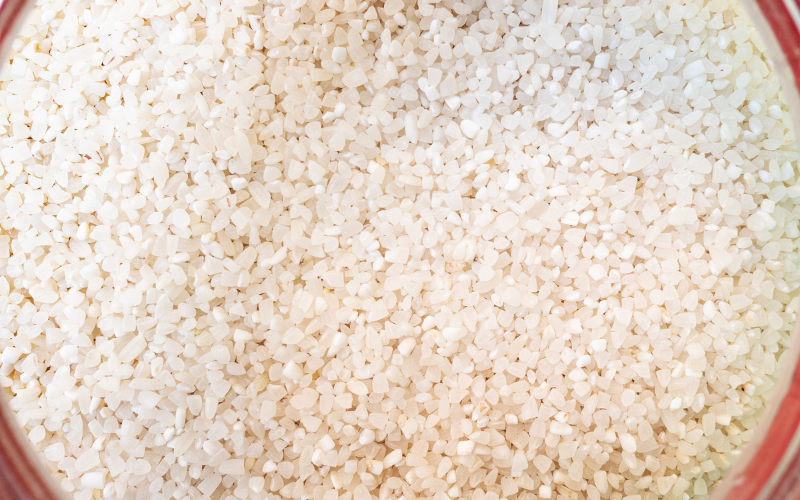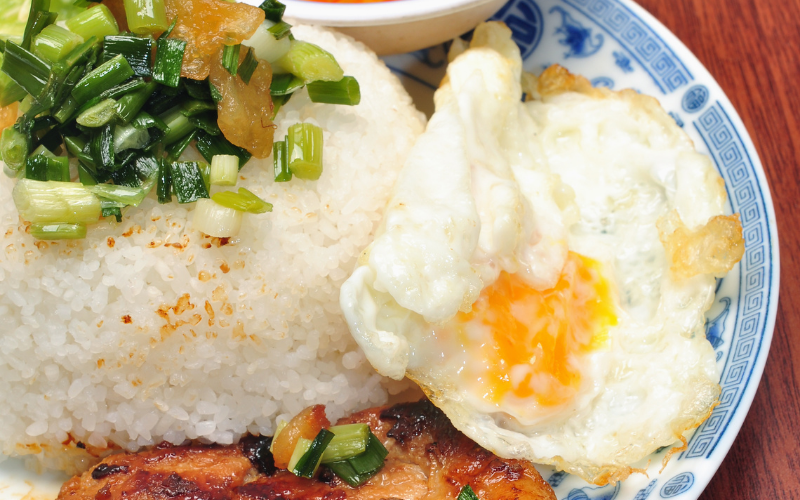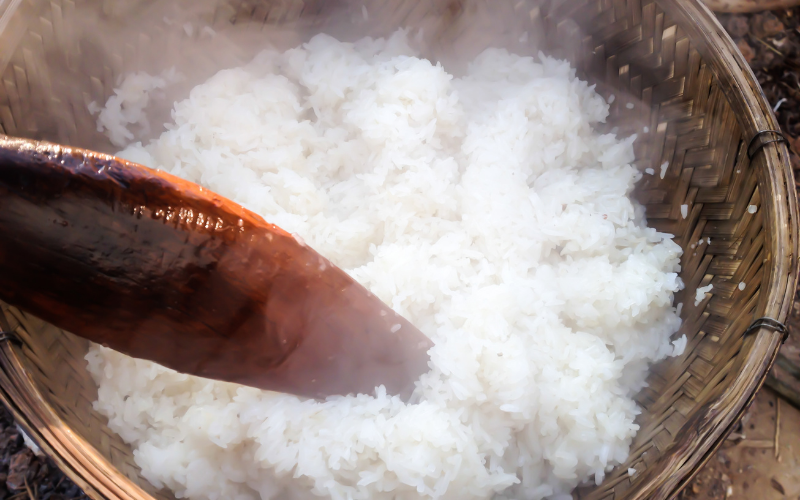What is broken rice? This seemingly simple question unravels a world of intriguing secrets and culinary wonders. Broken rice, often underestimated for its fragmented appearance, holds a special place in the hearts of food enthusiasts and chefs alike. Beyond its origins as a byproduct of rice milling, broken rice has risen to prominence, becoming a staple ingredient in various cuisines across the globe. Join us on a journey to explore the fascinating story of broken rice, from its ancient roots to its diverse culinary uses and nutritional benefits. Whether you’re a curious foodie or an aspiring chef, prepare to be captivated by the versatility and charm of this remarkable grain.
Maybe you will be curious: How Many Grains Of Rice In A Cup?
The Origins of Broken Rice
Broken rice has a fascinating history that traces back to ancient civilizations. Initially considered a byproduct of rice milling, broken rice eventually earned its reputation as a distinct grain with its own unique qualities. The origins of broken rice can be found in traditional rice cultivation regions, where it quickly became a staple ingredient in various dishes.
The Rice Milling Process

The rice milling process is a crucial step in the production of rice, transforming raw paddy grains into the polished white rice we commonly consume. This intricate process involves a series of steps designed to remove the husk, bran, and germ from the paddy, revealing the edible rice grain within.
The first step in the milling process is cleaning, where the harvested paddy is thoroughly inspected and any foreign materials or impurities are removed. Next comes dehusking, where the outer husk is mechanically or manually stripped away, leaving behind brown rice with the bran intact.
To obtain white rice, the bran layer must be further removed through a process known as whitening or polishing. This involves using abrasion to rub off the bran, resulting in the characteristic white appearance of polished rice. At this stage, the rice still retains its original length.
The final step, known as grading or sorting, involves separating the polished rice into various categories based on size, shape, and quality. This ensures that consumers receive rice of consistent quality, free from any remaining impurities.
The rice milling process is a delicate balance between preserving the nutritional value of the grain while enhancing its appearance and taste. Each step requires precision and expertise to achieve the desired final product. By mastering this process, rice producers are able to deliver a wide range of rice varieties, each with its unique culinary applications and characteristics.
Read: How Much Water For 2 Cups Of Rice?
The Advantages of Broken Rice
Broken rice offers several advantages that make it a preferred choice in certain culinary traditions and cooking practices:
- Enhanced Absorption: Broken rice has a higher surface area due to its fragmented nature, allowing it to absorb flavors and liquids more efficiently during cooking. This makes it ideal for dishes like biryanis, pilafs, and risottos, where the rice takes on the rich and savory essence of the accompanying ingredients.
- Reduced Cooking Time: Due to its smaller size, broken rice cooks faster than whole grains, saving valuable time in the kitchen. This quality makes it a convenient option for quick and easy meals or when cooking in large quantities.
- Tender Texture: Broken rice has a softer texture compared to long-grain rice, lending a comforting mouthfeel to dishes. This characteristic makes it a popular choice for making creamy rice puddings, congees, and porridges.
- Versatility: Broken rice is incredibly versatile and adapts well to various cooking methods. It can be steamed, boiled, fried, or used in soups, allowing chefs and home cooks to explore a wide range of culinary possibilities.
- Economical Value: Since broken rice is considered a byproduct of rice milling, it is often more affordable than whole grains. This affordability makes it an attractive option for cost-conscious consumers and communities with limited resources.
- Ideal for Baby Food: The soft and easily digestible texture of broken rice makes it a suitable option for making baby food or meals for individuals with dietary restrictions or sensitive stomachs.
- Thicker Sauces and Gravies: When used in certain dishes, broken rice releases starch more readily during cooking, leading to thicker and creamier sauces and gravies that enhance the overall taste experience.
- Suitable for Desserts: Broken rice is a popular choice for crafting delectable rice-based desserts such as rice pudding, sweet rice cakes, and various traditional sweets in different cultures.
What is broken rice used for?
In Vietnam, the most famous dish that commonly uses broken rice is “Cơm Tấm“. Cơm Tấm is a popular Vietnamese dish that originated in Southern Vietnam and has become a beloved staple throughout the country.

Traditionally, Cơm Tấm was created as a way to utilize broken rice, which was considered a byproduct of rice milling. The dish consists of broken rice grains, which are shorter and softer than whole grains, making it ideal for absorbing the flavorful marinades and sauces that accompany the dish.
The main protein component of Cơm Tấm is typically grilled pork (often called “thịt nướng”), which is marinated in a sweet and savory sauce, imparting a delicious smoky flavor to the meat. The dish is often served with a variety of accompaniments, such as pickled vegetables (đồ chua), sliced cucumbers, tomatoes, and fresh herbs like cilantro and mint.
In addition to grilled pork, Cơm Tấm can also be served with other protein options such as shredded pork skin (bì), grilled shrimp, grilled chicken, or fried egg. A drizzle of fish sauce-based dressing known as “nước mắm” ties all the flavors together, creating a harmonious and satisfying meal.
Cơm Tấm is typically enjoyed as a hearty and flavorful lunch or dinner option, served at street food stalls, local eateries, and restaurants across Vietnam. Its widespread popularity is a testament to the creativity and ingenuity of Vietnamese cuisine, turning what was once considered a byproduct into a beloved and iconic dish that delights both locals and visitors alike.
Nutritional Benefits of Broken Rice
| Nutrient | Amount per 100g |
|---|---|
| Calories | 362 kcal |
| Carbohydrates | 79.4 g |
| – Dietary Fiber | 1.3 g |
| – Sugars | 0.2 g |
| Protein | 7.1 g |
| Fat | 1.0 g |
| – Saturated Fat | 0.3 g |
| – Trans Fat | 0.0 g |
| Cholesterol | 0 mg |
| Sodium | 0 mg |
| Potassium | 73 mg |
| Calcium | 7 mg |
| Iron | 0.8 mg |
| Magnesium | 24 mg |
| Vitamin C | 0 mg |
| Vitamin B6 | 0.2 mg |
| Folate (Vitamin B9) | 5 mcg |
| Zinc | 0.7 mg |
Cooking Tips and Techniques

When cooking broken rice, there are several essential points to keep in mind to ensure the best results:
- Rinsing the Rice: Always rinse broken rice thoroughly under cold water before cooking. This step helps remove excess starch and prevents the rice from becoming overly sticky.
- Water-to-Rice Ratio: Use the right water-to-rice ratio to achieve the desired texture. Generally, 1.5 to 2 cups of water per cup of broken rice is recommended, but adjust the ratio based on your preference and the specific recipe.
- Soaking the Rice: Consider soaking broken rice in water for 15-30 minutes before cooking. Soaking can reduce cooking time and improve the texture of the rice.
- Simmering over Low Heat: Cook broken rice over low heat with the lid on to allow it to absorb the water evenly. Avoid lifting the lid frequently, as it may interrupt the cooking process and affect the final texture.
- Fluffing the Rice: After cooking, let the broken rice rest for a few minutes before fluffing it with a fork. Gently fluffing the rice helps separate the grains and prevents clumping.
- Adding Aromatics: To enhance the flavor of broken rice, consider cooking it with aromatic ingredients like bay leaves, cinnamon sticks, or star anise.
- Broth or Stock: For extra flavor, cook broken rice in vegetable or chicken broth instead of plain water. This adds depth to the rice, complementing various dishes.
- Using Day-Old Rice for Fried Rice: If making fried rice, use day-old cooked broken rice. The slightly dried-out texture of older rice prevents it from becoming mushy when stir-fried. (Read How To Fix Mushy Rice?)
- Steaming Method: Steaming broken rice in a rice cooker or steamer produces a light and fluffy texture, making it an excellent option for many dishes.
- Proper Storage: If you have leftover cooked broken rice, store it in an airtight container in the refrigerator. When reheating, add a splash of water or broth to help retain its moisture and fluffiness.
Also read: How Long Do Rice Cookers Take?
How to Store Broken Rice Properly?
Properly storing broken rice is essential to maintain its freshness and quality for extended periods. Follow these guidelines to store broken rice correctly:
- Choose an Airtight Container: Transfer the broken rice into a clean, dry, and airtight container. A glass jar or a food-grade plastic container with a tight-fitting lid works well to keep moisture and pests out.
- Store in a Cool, Dry Place: Find a cool and dry storage location, away from direct sunlight and sources of heat. Heat and humidity can cause the rice to spoil or become infested with pests.
- Avoid Moisture Exposure: Moisture is the enemy of stored rice, as it can lead to mold growth and spoilage. Ensure the container is completely dry before adding the broken rice and avoid storing it near the sink or any areas prone to high humidity.
- Keep Away from Strong Odors: Broken rice can absorb odors from its surroundings, affecting its taste and aroma. Avoid storing it near strong-smelling items like spices or cleaning agents.
Read more:
FAQs
Is broken rice the same as regular rice?
No, broken rice is not the same as regular rice. Broken rice is a type of rice that has been fractured or broken during the milling process, resulting in shorter grains with varying lengths. On the other hand, regular rice, also known as whole grain rice, consists of intact, unbroken grains with uniform length. While both broken rice and regular rice come from the same rice plant, they have distinct appearances and textures, and broken rice is often used in specific culinary applications due to its unique characteristics.
Is broken rice the same as jasmine rice?
No, broken rice is not the same as jasmine rice. Jasmine rice is a specific variety of aromatic rice known for its fragrant aroma and slightly sticky texture when cooked. On the other hand, broken rice refers to rice grains that have been fractured or broken during the milling process, which can occur with various rice varieties, including jasmine rice. While broken jasmine rice may still retain its characteristic fragrance, it will have a different appearance and texture compared to whole jasmine rice grains.
Why is broken rice so cheap?
Broken rice is generally cheaper than whole rice grains due to its appearance and processing. It is considered a byproduct of rice milling, where some grains break during the milling process, resulting in shorter and fragmented pieces. Because of its uneven appearance, broken rice is often perceived as less desirable for retail sale.
Can I break rice to make broken rice?
Yes, you can break rice to make broken rice, but the process may be challenging and time-consuming. Breaking rice manually requires significant effort, and it may not result in uniform pieces. For commercial production and consistency, broken rice is typically obtained during the rice milling process, where machines efficiently remove the outer husk and sometimes cause grains to break.
Read more: How Much Rice Per Person?
Conclusion
We have delved into the captivating world of broken rice, exploring its origins, culinary uses, nutritional benefits, and more. Now, we can confidently answer the question, “What is broken rice?” Broken rice is a remarkable and versatile grain that has transcended its humble beginnings as a byproduct of rice milling to become a cherished ingredient in various cuisines worldwide.
Throughout history, broken rice has shown its adaptability and unique properties, making it a preferred choice in many dishes. Its ability to absorb flavors, reduced cooking time, and tender texture set it apart from whole rice grains. From delightful rice puddings to savory rice-based entrees like Cơm Tấm in Vietnam, broken rice has earned its place as an essential staple in numerous cultures.
Moreover, broken rice’s nutritional value cannot be overlooked. It provides essential carbohydrates, protein, and vital nutrients that contribute to a balanced and healthy diet.